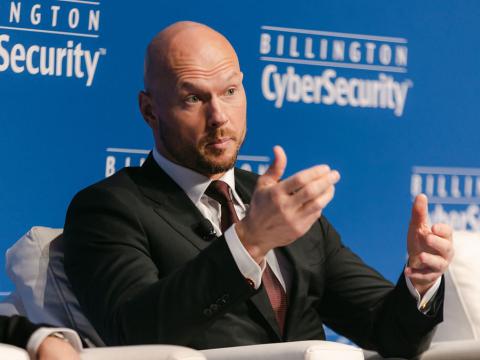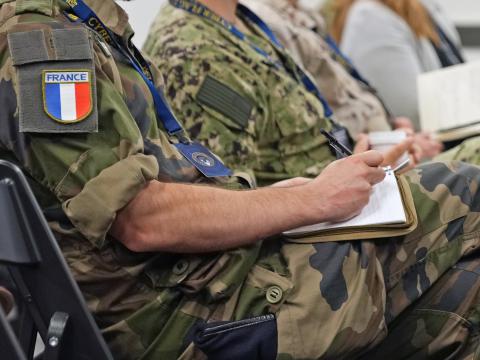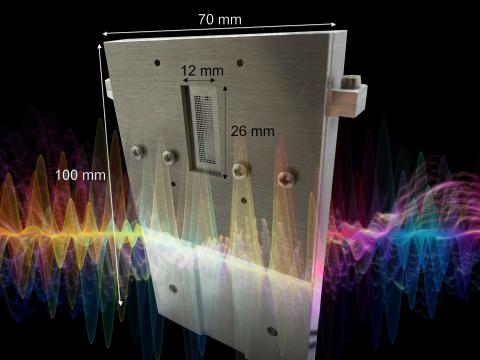Look-to-Speak Applications Go to Sea
Inexpensive, diode-based equipment permits covert transmissions for a variety of operations. 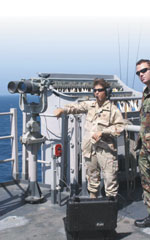
The LightSpeed system converts optical equipment such as this U.S. Navy Big Eyes shipboard binocular system into communications devices. An add-on eyepiece attachment allows Big Eyes and other types of binoculars to transmit voice, video and data to another LightSpeed system.
Binoculars may become the U.S. Navy’s next tactical communications system. A prototype technology allows optical viewing systems to transmit voice, video and data communications on a beam of non-laser light. The equipment can be easily fitted to any commercially available binoculars and provides warfighters with a way to coordinate operations without relying on radios.
Known as LightSpeed, the system was developed through a science and technology partnership between the U.S. Navy’s Space and Naval Warfare (SPAWAR) Systems Center, Charleston, South Carolina; the Office of Naval Research (ONR), Arlington, Virginia; and Torrey Pines Logic, San Diego. The prototype device fits onto one side of a binocular eyepiece and contains a miniaturized series of nine to 14 light-emitting diodes (LEDs). Its power requirements range between 250 milliwatts to 1 watt of power, depending on the type of transmission. The LEDs generate energy and pulse into a prism containing a Torrey Pines Logic-designed beam splitter that directs the light beam out of one of the oculars.
One side of the binocular is used for data transmission, while the other ocular receives information. According to Gregory Hays, chief technology officer for the Command and Control Department at
LightSpeed originated almost two years ago from an online request for a tactical solution. The ONR maintains a Web portal called Tech Solutions, an e-business-based site that encourages sailors and Marines to identify emerging technology needs that can be satisfied quickly. Users post a challenge question on the site and offer some potential solutions. The ONR then takes these suggestions and contacts all of its various warfighter, software and engineering centers that bid to provide a solution.
The ONR places a key limitation on the solution—it must be developed and produced in 12 months or less. Hays explains that this process involves little original research and instead focuses on existing systems that can be modified to meet warfighter needs. “The hope is that there are opportunities to transition [the technology]. The program fills the gaps that exist outside of Navy and Marine Corps science and technology investments,” he says.
The question that launched LightSpeed was asked by Cmdr. Gisele Bonitz, USN, of the USS Coronado, the command ship for the 3rd Fleet. The commander queried whether there was a means of conducting ship-to-ship communications under radio silence. A contributing factor to the question was that the Navy eliminated the rating of signalman in 2004. Signalmen used semaphore flags and signal lamps to communicate with other vessels during emission control (EMCON) operations. “The notion of doing signal lights seemed rudimentary compared to today’s on-demand, wireless, real-time technology. But we had a huge challenge because EMCON RF [radio frequency] was not an option,” he says.
SPAWAR Charleston and Torrey Pines Logic won the bid for the solution. Their idea was to modify existing Navy optical systems such as Big Eyes—large binoculars mounted on each side of a ship and used as navigation aides to detect buoys and other vessels. Hays’ group proposed to add an eyepiece attachment to the binoculars to transmit digital voice, video and data through the existing optics. He notes that the eyepiece for Big Eyes is the same size as a standard issue pair of U.S. Marine Corps binoculars. “We claimed that this attachment could be adaptable to both a handheld binocular and the shipborne Big Eyes,” he says.
Hays notes that other competing solutions involved installing gimbals for laser communications systems or new types of optics. SPAWAR Charleston’s approach was to use existing optical systems to design a technology that was adaptable and simple to use and that could be attached to existing equipment.
A prototype was ready within 10 months. A Big Eyes set that had been returned for refurbishment was used as a testbed to demonstrate that a signal could be transmitted through the binoculars with LEDs. The diodes were attractive because they are low-powered, commercially available devices. “A key decision was that whatever we chose, once we got out of the prototype phase, we wanted this thing to be mass produced for under $1,000 [each]. In order for it to be useful for a handheld binocular, it could not exceed the actual production cost by much,” he says.
After the technology was proved during the program’s first phase, the transmission signal was moved to an all-digital format. Two LightSpeed-fitted Big Eyes systems successfully transferred voice, video and data at 1 megabit per second throughput at a distance of two nautical miles.
Torrey Pines Logic specializes in developing error correction and optics. The firm used a previously developed packaging protocol to manage the transfer protocol from an Internet protocol to a serial connection. The SPAWAR team then used a code division multiple access (CDMA) protocol as a transfer medium between the two devices. “The beauty of CDMA is that by its nature it is very covert. You actually have to establish a public and private key on each end of the units. It’s a spread spectrum technology,” he says.
A major advantage of using LEDs is that the transmission is spread across the entire field of view of the optics. Because a set of binoculars may have a 7-degree field of view, two users with identical binoculars standing one mile apart can paint a very large picture with LightSpeed. Operationally, if two ships are viewing each other, the signal is spread across the optic’s entire field of view, so even if both vessels are moving in heavy seas, connectivity is established as long as they remain in each other’s field of view. This wide-angle capability is important because traditional lasers have very tight beams that require stabilization systems, which greatly increases per unit costs. Like laser-based systems, the technology is nearly impossible to detect or intercept because both operators must be looking at each other to communicate.
The contract is in its second phase. In November 2005, the SPAWAR team delivered four LightSpeed-equipped Big Eyes units to Expeditionary Strike Group 1 located in
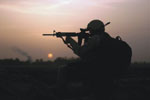 |
| Because it can be attached to most handheld optical systems, LightSpeed could be used in a variety of applications such as soldiers’ riflescopes and periscopes. |
The ONR recently authorized phase three funding, which will use the lessons learned from the system’s deployment with the Expeditionary Strike Group to produce a final prototype. The goal is to take this prototype through the Navy’s process for accreditation and certification. Hays explains that the units left aboard the
In June, two pairs of LightSpeed systems were part of Triton Warrior 06, the Navy’s FORCEnet sea trial venue held in
Hays shares that the fleet has expressed interest in the system and that various groups such as explosive ordnance disposal personnel like the system because it allows them to communicate without radio frequency systems. “We are starting to establish a possible market for easy and cheap mobile shipboard communications. We’re not advertising very high bandwidth, only 1 megabit per second. We may go marginally higher, but we’re not going to be in the gigabit range. But we can do full motion video, carry a lot of e-mail traffic, transfer files and provide high-quality digital voice,” he says.
The maturity of the LightSpeed system also creates the possibility for other applications such as unassisted landings for unmanned aerial vehicles, optical communications on aircraft carrier flight decks and vehicle convoy communications in urban environments. “There’s a whole variety of possibilities that are open now because it’s been proven that you can do it with LEDs very cheaply, very high-quality and not have to rely on radio frequencies,” he says.
Although initial tests were conducted at two nautical miles, LightSpeed-equipped binoculars can transmit and receive signals at distances of up to 12 miles. But Hays cautions that these distances depend on the quality of the optics and prevailing atmospheric conditions.
Hays is confident that advances in LED frequency modulation will achieve five to 10 times the data throughput of the current prototype, which uses commercial grade, 850-nanometer LEDs operating on a single frequency. The beam produced by the diodes is invisible and eye-safe. “If we took different frequencies of LEDs and combined them, we could triple our bandwidth immediately,” he says.
Another potential niche for the technology is to communicate in foreign nations with restrictive radio frequency allocation rules or to avoid the necessity of laying down physical infrastructure. However, he notes that the technology is for line-of-sight communications.
There are some proposals to combine the technology with ocular systems such as gun scopes and periscopes. Additional potential uses include an omnidirectional capability where the system could be mounted on a ship’s mast or on a vehicle, eliminating the constraining activity of looking through a pair of binoculars.
Web Resources
SPAWAR
ONR Tech Solutions: www.techsolutions.navy.mil
Torrey Pines Logic: www.tplogic.com
